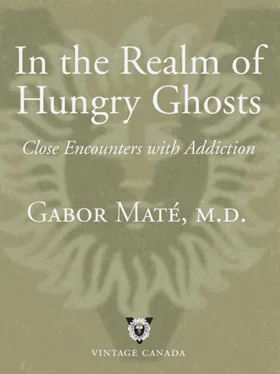
PART IV

How the Addicted Brain Develops
If our society were truly to appreciate the significance of children’s emotional ties throughout the first years of life, it would no longer tolerate children growing up, or parents having to struggle, in situations that cannot possibly nourish healthy growth.
STANLEY GREENSPAN, M.D.
CHILD PSYCHIATRIST AND FORMER DIRECTOR, CLINICAL
INFANT DEVELOPMENT PROGRAM, [U.S.] NATIONAL
INSTITUTE OF MENTAL HEALTH
CHAPTER 17

Their Brains Never Had a Chance
My first book, Scattered Minds, published in 2000, dealt with attention deficit disorder, a condition I myself have. It so happens that ADD is a major risk factor for addiction to a number of substances, including nicotine, cocaine, alcohol, cannabis and crystal meth, and also for gambling and other behavioural addictions—but that’s not why I’m mentioning the book here. Rather, I want to tell an anecdote from just before its publication.
In Scattered Minds , I had laid out some well-established research evidence showing that the mammalian brain develops largely under the influence of the environment, rather than according to strict genetic predetermination—and that this is especially the case with the human brain. These findings were relatively recent but by then wholly uncontroversial, at least in brain science circles. They were not obscure academic secrets but had been the subjects of cover articles in both Time and Newsweek.
I was speaking on the phone with a young producer who had called me from Toronto to discuss a possible studio interview on a national television program. We were going over what material I might present on the air. I was just getting into some of the more fascinating of the research points when she interrupted me. “Wait. You mean to tell me that the size of a mother’s pupils and how she looks at her baby will affect the chemistry of the kid’s brain?” “Not only will it,” I said, “it does so instantaneously!” I was on a roll, certain that this producer was just as enthralled as I with the insights of developmental neuroscience. “Over time, if there’s a pattern of—”
“That’s ridiculous,” she said, interrupting a second time. “There’s no way we can use that.” And before I could ask her on what grounds she was rejecting the fruits of several decades of scientific investigation, she hung up.
That a TV producer, or any layperson for that matter, would have trouble accepting the new brain science is understandable, given the mind-body separation prevalent in our culture, and given, too, how long we’ve been taught that genes determine almost everything about a human being: personality traits, behaviour, eating patterns and all manner of disease. Much more perplexing is the fact that this new knowledge is virtually unfamiliar to the medical community. Despite the thousands of research papers published in leading scientific and medical journals, countless monographs and conference documents and several outstanding academic books on the subject, the role of the environment in brain development isn’t taught in many medical schools. 1It’s not incorporated into our work with children or adults. Not only is brain development ignored in medical training, so is human psychological development. “It is astonishing to realize,” remarks neurologist Antonio Damasio, “that [medical] students learn about psychopathology without ever being taught normal psychology.” 2
Such neglect is a loss for medical practice, and for millions of patients. Greater awareness of developmental influences on brain functioning and the personality would enrich and empower every field of medicine. And if more doctors knew what there is to know about this, I am convinced it would encourage a radical and overdue rethinking of social attitudes towards addiction.
Brain development in the uterus and during childhood is the single most important biological factor in determining whether or not a person will be predisposed to substance dependence and to addictive behaviours of any sort, whether drug-related or not. Startling as this view may appear to be at first sight, it is amply supported by recent research. Dr. Vincent Felitti was chief investigator in a landmark study of over seventeen thousand middle-class Americans for Kaiser Permanente and the [U.S.] Centres for Disease Control. “The basic cause of addiction is predominantly experience-dependent during childhood, and not substance-dependent,” Dr. Felitti has written. “The current concept of addiction is ill-founded.” 3
To state that childhood brain development has the greatest impact on addiction is not to rule out genetic factors. However, the emphasis placed on genetic influences in addiction medicine—and in many other areas of medicine—is an impediment to our understanding.

“The human brain, a 3-pound mass of interwoven nerve cells that controls our activity, is one of the most magnificent—and mysterious—wonders of creation. The seat of human intelligence, interpreter of senses, and controller of movement, this incredible organ continues to intrigue scientists and laymen alike.”
With these words President George H.W. Bush inaugurated the 1990s as “the decade of the brain.” In the United States there followed an inspiring expansion of research into the workings and development of the brain. When the findings were collated, together with previously available information, a fresh and exciting view of brain development emerged. Old assumptions were discarded and a new paradigm established. Many of the details remain to be discovered, of course—the work of centuries, suggests Professor Jaak Panksepp in Affective Neuroscience —but the outlines are not in doubt. The view that genes play a decisive role in the way a person’s brain develops has been replaced by a radically different notion: the expression of genetic potentials is, for the most part, contingent on the environment. Genes do dictate the basic organization, developmental schedule and anatomical structure of the human central nervous system, but it’s left to the environment to sculpt and fine-tune the chemistry, connections, circuits, networks and systems that determine how well we function.
Of all the mammals, we humans have the least mature brain at birth. Early in their infancy other newborn animals perform tasks far beyond the capabilities of human babies. A horse, for example, can run on its first day of life. Not for a year and a half or more can most humans muster the muscle strength, visual acuity and neurological control skills—perception, balance, orientation in space, coordination—to perform that activity. In other words, the horse’s brain development at birth is at least a year and a half ahead of our own—probably even more, in horse years.
Why are we saddled with such a disadvantage in comparison to a horse? We can think of it as a compromise imposed by Nature. Our evolutionary predecessors were permitted to walk upright, which freed forelimbs to evolve into arms and hands capable of many delicate and complicated activities. Those advances in manual versatility and dexterity required a tremendous enlargement of the brain, especially of its frontal areas. Our frontal lobes, which coordinate the movement of our hands, are much larger even than those of our closest evolutionary relative, the chimpanzee. These lobes, particularly their prefrontal areas, are also responsible for the problem solving, social and language skills that have allowed humankind to thrive. As we became a two-legged species, the human pelvis had to narrow to accommodate our upright stance. At the end of the nine months of human gestation the head forms the largest diameter of the body, the one most likely to get stuck in our journey through the birth canal. It’s simple engineering: any further brain growth in the uterus and we couldn’t be born.
Читать дальше















